Ordered Mesoporous Materials: Unlocking New Frontiers in Science and Industry
Ordered mesoporous materials have demonstrated immense potential across various fields, including catalysis [1], adsorption, separation, energy conversion and storage [2], environmental processing [3], sensing, information technology, electronic devices [4], and biomedicine [5]. These materials exhibit exceptional properties such as:
- Large pore diameter (2–50 nm),
- High specific surface area,
- Large pore volume,
- Adjustable pore structure and morphology,
- Diverse skeleton compositions, and
- Easily modifiable surfaces.
Moreover, mesoporous materials serve as nanoscale microreactors, enabling studies on the nanoconfinement effect, small size effect, surface effect, and quantum effect of nanomaterials from a microscopic perspective.

Mesoporous titanium dioxide is used in optoelectronic devices[4]
J&K Scientific's Functional Mesoporous Materials
J&K Scientific exclusively offers a range of innovative mesoporous materials developed by Academician Zhao Dongyuan of Fudan University. These materials are distinguished by the following advantages:
- Diverse Composition: Ten different types are available, including inorganic, organic, and metal oxides like silica, carbon, and titanium dioxide, enriching the mesoporous material options.
- Highly Ordered Structure: With a high specific surface area, large pore volume, and narrow pore size distribution, these materials show excellent potential for applications in various fields.
- Surface Functionalization: Their surfaces are easily functionalized with groups such as sulfhydryl, amino, epoxide, and imidazole.
- Excellent Dispersion: The particles exhibit good dispersion and resistance to agglomeration or settling, supporting advanced research in catalysis, adsorption, and separation.
Mesoporous Silica Applications
Mesoporous silica is particularly versatile and finds applications in:
- Catalyst Carriers: For substances such as precious metals and metal oxides.
- Pollutant Adsorbents and Detectors: For compounds like H₂S, formaldehyde, and algal toxins.
- Nanomedicine Carriers: For biomolecules like cytochrome C and serum protein.
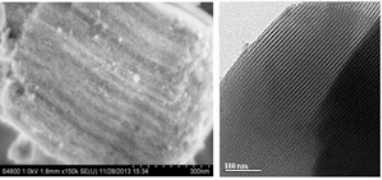
average particle size:500-2000 nm
Two-dimensional hexagonal structure(p6mm)
Specific surface area:700-1100 m2g-1
Aperture:6-11 nm
Pore volume:0.6-1.3 cm3g-1
Good dispersion in water and ethanol
Surface-modifiable groups: thiol, amino, epoxide, imidazole, etc.
literature:Science, 1998, 279, 548
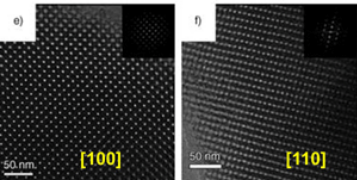
average particle size:> 1000 nm
Body-centered cubic structure
Specific surface area:600-960 m2g-1
Aperture:5-12 nm
Pore volume:0.50-0.95 cm3g-1
Good dispersion in water and ethanol
Surface-modifiable groups: thiol, amino, epoxide, imidazole, etc.
literature:J. Am. Chem. Soc., 1998, 120, 6024
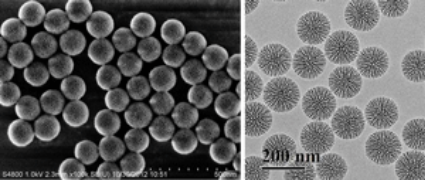
average particle size:60-250 nm
Three-dimensional dendritic mesoporous channels
Specific surface area:410-680 m2g-1
Aperture:2.8-13.3 nm
Pore volume:0.57-1.66 cm3g-1
Good dispersion in water and ethanol
Surface-modifiable groups: thiol, amino, epoxide, imidazole, etc.
literature:Nano Lett., 2014, 14, 923

average particle size:120-250 nm
There are hollow tubes on the spherical surface, forming a sea urchin-like shape
Specific surface area:200-450 m2g-1
Aperture:2.0-3.0 nm
Pore volume:0.35-0.56 cm3g-1
Good dispersion in water and ethanol
Surface-modifiable groups: thiol, amino, epoxide, imidazole, etc.
literature:ACS Cent. Sci., 2017, 3, 839
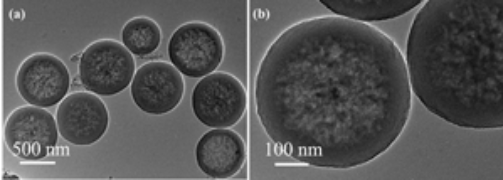
average particle size:200-800 nm
The outer shell is mesoporous silica, and the inner shell is hollow structure.
Specific surface area:350-800 m2g-1
Aperture:2-4 nm
Pore volume:0.6-1.4 cm3g-1
Surface-modifiable groups: thiol, amino, epoxide, imidazole, etc.
Good dispersion in water and ethanol
Mesoporous Carbonm
Application areas: oil-water separators; electrode materials (such as batteries and supercapacitors); catalyst carriers (such as precious metals, metal oxides, etc.); organic pollutant adsorbents (such as acetone, benzene, rhodamine B, etc.); nanofilters ( Such as inorganic nanoparticles, biomolecules)
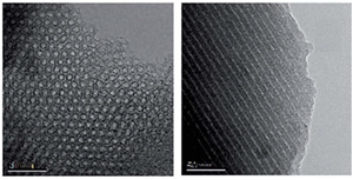
average particle size:> 1000 nm
Two-dimensional hexagonal structure(p6mm)
Specific surface area:540-1500 m2g-1
Aperture:3.5-8.0 nm
Pore volume:0.4-1.31 cm3g-1
Good dispersion in organic solvents
Surface-modifiable groups: carboxyl, phenolic hydroxyl, acid anhydride and other oxygen-containing groups
literature:Angew. Chem. Int. Ed., 2005, 44, 7053
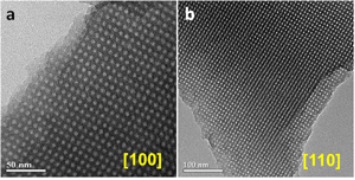
average particle size:> 1000 nm
Body-centered cubic structure
Specific surface area:510-900 m2g-1
Aperture:3.7-6.8 nm
Pore volume:0.4-0.85 cm3g-1
Good dispersion in organic solvents
Surface-modifiable groups: carboxyl, phenolic hydroxyl, acid anhydride and other oxygen-containing groups
literature:Angew. Chem. Int. Ed., 2005, 44, 7053
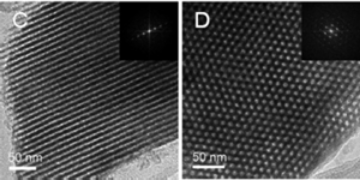
average particle size:> 1000 nm
Two-dimensional hexagonal structure(p6mm)
Specific surface area:800-1130 m2g-1
Aperture:2.0-4.0 nm
Pore volume:0.8-1.52 cm3g-1
Good dispersion in organic solvents
literature:J. Am. Chem. Soc., 2006, 128, 11652
Mesoporous Carbon-silicon Composites
Application fields: Unique "reinforced concrete" structural inorganic-organic composite materials can be used as catalyst carriers (such as precious metals, metal oxides, etc.); inorganic/organic pollutant adsorbents and detectors (such as acetone, benzene, rhodamine B wait)
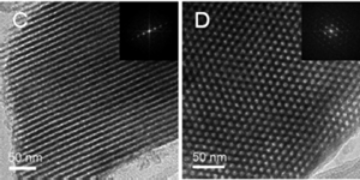
average particle size:> 1000 nm
Two-dimensional hexagonal structure(p6mm)
Specific surface area:280-600 m2g-1
Aperture:2.2-6.8 nm
Pore volume:0.21-0.58 cm3g-1
Good dispersion in organic solvents
Surface-modifiable groups: thiol, amino, imidazole and some oxygen-containing groups
literature:J. Am. Chem. Soc., 2006, 128, 11652
Mesoporous Titanium Dioxide
Application areas: electrode materials (such as dye-sensitized solar cells); photocatalysts (such as photocatalytic hydrogen production, photocatalytic degradation of organic pollutants, etc.)
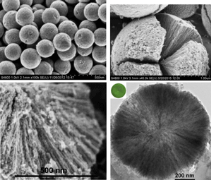
average particle size:600-2500 nm
Two-dimensional hexagonal structure (p6mm), radial mesoporous channels
Specific surface area:80-157 m2g-1
Aperture:5.0-12 nm
Pore volume:0.2-0.56 cm3g-1
Good dispersion in water and ethanol
literature:Sci. Adv., 2015 ,1(4), e1500166.
References
- Dengke Shen, Lei Chen, Jianping Yang, Renyuan Zhang, Yong Wei, Xiaomin Li, Wei Li, Zhenkun Sun, Hongwei Zhu, Aboubakr M. Abdullah, Abdullah Al-Enizi, Ahmed A. Elzatahry, Fan Zhang, Dongyuan Zhao. ACS Appl. Mater. Interfaces. 2015, 7, 17450-17459.
- Zhenhui Liu, Doudou Guan, Qiang Yu, Lin Xu, Zechao Zhuang, Ting Zhu, Dongyuan Zhao, Liang Zhou, Liqiang Mai. Energy Storage Mater. 2018, 13, 112-118.
- Wei Teng, Zhangxiong Wu, Dan Feng, Jianwei Fan, Jinxiu Wang, Hao Wei, Mingjuan Song, Dongyuan Zhao. Environ. Sci. Technol., 2013,47, 8633-8641.
- Yong Liu, Renchao Che, Gang Chen, Jianwei Fan, Zhenkun Sun, Zhangxiong Wu, Minghong Wang, Bin Li, Jing Wei, Yong Wei, Geng Wang, Guozhen Guan, Ahmed A. Elzatahry, Abdulaziz A. Bagabas, Abdullah M. Al-Enizi, Yonghui Deng, Huisheng Peng, Dongyuan Zhao. Sci. Adv. 2015 ,1, e1500166.
- Xiaomin Li, Lei Zhou, Yong Wei, Ahmed Mohamed El-Toni, Fan Zhang, Dongyuan Zhao. J. Am. Chem. Soc. 2014, 136, 15086-15092.
